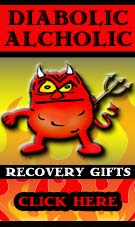The Jack Alexander Article
(From the March 1, 1941 issue of The Saturday Evening Post)

Alcoholics Anonymous
THREE MEN sat around the bed of an alcoholic patient in the psychopathic ward of Philadelphia General Hospital one afternoon a few weeks ago. The man in the bed, who was a complete stranger to them, had the drawn and slightly stupid look the inebriates get while being defogged after a bender. The only thing that was noteworthy about the callers, except for the obvious contrast between their well-groomed appearances and that of the patient, was the fact that each had been through the defogging process many times himself. They were members of Alcoholics Anonymous, a band of ex-problem drinkers who make an avocation of helping other alcoholics to beat the liquor habit.
The man in the bed was a mechanic. His visitors had been educated at Princeton, Yale and Pennsylvania and were, by occupation, a salesman, a lawyer and a publicity man. Less than a year before, one had been in shackles in the same ward. One of his companions had been what is known among alcoholics as a sanitarium commuter. He had moved from place to place, bedeviling the staffs of the country’s leading institutions for the treatment of alcoholics. The other had spent twenty years of life, all outside institution walls, making life miserable for himself, and his family and his employers, as well as sundry well-meaning relatives who had had the temerity to intervene.
The air of the ward was thick with the aroma of paraldehyde, an unpleasant cocktail smelling like a mixture of alcohol and ether which hospitals sometimes use to taper off the paralyzed drinker and soothe his squirming nerves. The visitors seemed oblivious of this and of the depressing atmosphere of psychopathic wards. They smoked and talked with the patient for twenty minutes or so, then left their personal cards and departed. If the man in the bed felt that he would like to see one of them again, they told him, he had only to put in a telephone call.
THEY MADE it plain that if he actually wanted to stop drinking, they would leave their work or get up in the middle of the night to hurry to where he was. If he did not choose to call, that would be the end of it. The members of Alcoholics Anonymous do not pursue or coddle a malingering prospect, and they know the strange tricks of the alcoholic as a reformed swindler knows the art of bamboozling.
Herein lies much of the unique strength of a movement, which in the past six years, has brought recovery to around 2,000 men and women, a large percentage of whom had been considered medically hopeless. Doctors and clergymen, working separately or together, have always managed to salvage a few cases. In isolated instances, drinkers have found their own methods of quitting. But the inroads into alcoholism have been negligible, and it remains one of the great, unsolved public-health enigmas.
By nature touchy and suspicious, the alcoholic likes to be left alone to work out his puzzle, and he has a convenient way of ignoring the tragedy which he inflicts meanwhile upon those who are close to him. He holds desperately to a conviction that, although he has not been able to handle alcohol in the past, he will ultimately succeed in becoming a controlled drinker. One of medicine’s queerest animals, he is, as often as not, an acutely intelligent person. He fences with professional men and relatives who attempt to aid him and he gets a perverse satisfaction out of tripping them up in argument.
THERE IS no specious excuse for drinking which the troubleshooters of Alcoholics Anonymous have not heard or used themselves. When one of their prospects hands them a rationalization for getting soused, they match it with a half a dozen out of their own experience. This upsets him a little, and he gets defensive. He looks at their neat clothing and smoothly shaved faces and charges them with being goody-goodies who don’t know what it is to struggle with drink. They reply by relating their own stories: the double Scotches and brandies before breakfast; the vague feeling of discomfort which precedes a drinking bout; the awakening from a spree without being able to account for the actions of several days and the haunting fear that possibly they had run down someone with their automobiles.
They tell of the eight-ounce bottles of gin hidden behind pictures and in caches from cellar to attic; of spending whole days in motion-picture houses to stave off the temptation to drink; of sneaking out of the office for quickies during the day. They talk of losing jobs and stealing money from their wives’ purses; of putting pepper into whiskey to give it a tang; of tippling on bitters and sedative tablets, or on mouthwash or hair tonic; of getting into the habit of camping outside the neighborhood tavern ten minutes before opening time. They describe a hand so jittery that it could not lift a pony to the lips without spilling the contents; drinking liquor from a beer stein because it can be steadied with two hands, although at the risk of chipping a front tooth; tying an end of a towel about a glass, looping the towel around the back of the neck, and drawing the free end with the other hand; hands so shaky they feel as if they were about to snap off and fly into space; sitting n hands for hours to keep them from doing this.
These and other bits of drinking lore usually manage to convince the alcoholic that he is talking to blood brothers. A bridge of confidence is thereby erected, spanning a gap, which has baffled the physician, the minister, the priest, or the hapless relatives. Over this connection, the troubleshooters convey, bit by bit, the details of a program for living which has worked for them and which, they feel, can work for any other alcoholic. They concede as out of their orbit only those who are psychotic or who are already suffering from the physical impairment known as wet brain. At the same time, they see to it that the prospect gets whatever medical attention is needed.
MANY DOCTORS and staffs of institutions throughout the country now suggest Alcoholics Anonymous to their drinking patients. In some towns, the courts and probation officers cooperate with the local group. In a few city psychopathic divisions, the workers of Alcoholics Anonymous are accorded the same visiting privileges as staff members. Philadelphia General is one of these. Dr. John F. Stouffer, the chief psychiatrist, says: “the alcoholics we get here are mostly those who cannot afford private treatment, and this is by far the greatest thing we have ever been able to offer them. Even among those who occasionally land back in here again, we observe a profound change in personality. You would hardly recognize them”.
The Illinois Medical Journal, in an editorial last December, went further than D. Stouffer, in stating: “It is indeed a miracle when a person who for years has been more of less constantly under the influence of alcohol and in whom his friends have lost all confidence, will sit up all night with a drunk and at stated intervals administer a small amount of liquor in accordance with a doctor’s order without taking a drop himself.”
This is a reference to a common aspect of the Arabian Nights adventures to which Alcoholics Anonymous workers dedicate themselves. Often it involves sitting upon, as well as up with, the intoxicated person, as the impulse to jump out a window seems to be an attractive one to many alcoholics when in their cups. Only an alcoholic can squat on another alcoholic’s chest for hours with the proper combination of discipline and sympathy.
During a recent trip around the East and Middle West, I met and talked with scores of A.A.s, as they call themselves, and found them to be unusually calm tolerant people. Somehow, they seemed better integrated than the average group of nonalcoholic individuals. Their transformation from cop fighters, canned-heat drinkers, and, in some instances, wife beaters, was startling. On one of the most influential newspapers in the country, I found that the city editor, the assistant city editor, and a nationally known reporter were A.A.s, and strong in the confidence of their publisher.
IN ANOTHER city, I heard a judge parole a drunken driver to an A.A. member. The latter, during his drinking days, had smashed several cars and had had his own operator’s license suspended. The judge knew him and was glad to trust him. A brilliant executive of an advertising firm disclosed that two years ago he had been panhandling and sleeping in a doorway under an elevated structure. He had a favorite doorway, which he shared with other vagrants, and every few weeks he goes back and pays them a visit just to assure himself he isn’t dreaming.
In Akron, as in other manufacturing centers, the groups include a heavy element of manual workers. In the Cleveland Athletic Club, I had luncheon with five lawyers, an accountant, an engineer, three salesmen, an insurance man, a buyer, a bartender, a chain-store manager, a manager of an independent store, and a manufacturer’s representative. They were members of a central committee, which coordinates the work of nine neighborhood groups. Cleveland, with more than 450 members, is the biggest of the A.A. centers. The next largest are located in Chicago, Akron, Philadelphia, Los Angeles, Washington and New York. All told, there are groups in about fifty cities and towns.
IN DISCUSSING their work, the A.A.s spoke of their drunk rescuing as “insurance” for themselves. Experience within the group has shown, they said, that once a recovered drinker slows up in this work he is likely to go back to drinking himself. There is, they agreed, no such thing as an ex-alcoholic. If one is an alcoholic – that is, a person who is unable to drink normally – one remains an alcoholic until he dies, just as a diabetic remains a diabetic. The best he can hope for is to become an arrested case, with drunk saving as his insulin. At least, the A.A.s say so, and medical opinion tends to support them. All but a few said that they had lost all desire for alcohol. Most serve liquor in their homes when friends drop in, and they still go to bars with companions who drink. A.A.s tipple on soft drinks and coffee.
One, a sales manager, acts as bartender at his company’s annual jamboree in Atlantic City and spends his nights tucking the celebrators into their beds. Only a few of those who recover fail to lose the felling that at any minute they may thoughtlessly take one drink and skyrocket off on a disastrous binge. An A.A. who is a clerk in an Eastern city hasn’t had a snifter in three and a half years, but says that he still has to walk fast past saloons to circumvent the old impulse; but he is an exception. The only hangover from the wild days that plagues the A.A. is a recurrent nightmare. In the dream, he finds himself off on a rousing whooper-dooper, frantically trying to conceal his condition from the community. Even this symptom disappears shortly, in most cases. Surprisingly, the rate of employment among these people, who formerly drank themselves out of job after job, is said to be around ninety percent.
One-hundred-percent effectiveness with non-psychotic drinkers who sincerely want to quit is claimed by the workers of Alcoholics Anonymous. The program will not work, they add, with those who only “want to want to quit”, or who want to quit because they are afraid of losing their families or their jobs. The effective desire, the state, must be based upon enlightened self-interest; the applicant must want to get away from liquor to head off incarceration or premature death. He must be fed up with the stark social loneliness, which engulfs the uncontrolled drinker, and he must want to put some order into his bungled life.
As it is impossible to disqualify all borderline applicants, the working percentage of recovery falls below the 100-percent mark. According to A.A. estimation, fifty percent of the alcoholics taken in hand recover immediately; twenty-five percent get well after suffering a relapse or two; and the rest remain doubtful. This rate of success is exceptionally high. Statistics on traditional medical and religious cures are lacking, but it has been informally estimated that they are no more than two or three percent effective on run-of-the-mine cases.
Although it is too early to state that Alcoholics Anonymous is the definitive answer to alcoholism, its brief record is impressive, and it is receiving hopeful support. John D. Rockefeller, Jr. helped defray the expense of getting it started and has gone out of his way to get other prominent men interested.
ROCKEFELLER’S GIFT was a small one, in deference to the insistence of the originators that the movement be kept on a voluntary, non paid basis. There are no salaried organizers, no dues, no officers, and no central control. Locally, the rents of assemble halls are met by passing the hat at meetings. In small communities, no collections are taken, as the gatherings are held in private homes. A small office in downtown New York acts merely as a clearinghouse for information. There is no name on the door, and mail is received anonymously through a post-office box. The only income, which is money received from the sale of a book describing the work, is handled by the Alcoholic Foundation, a board composed of three alcoholics and four non-alcoholics.
In Chicago, twenty-five doctors work hand in hand with Alcoholics Anonymous, contributing their services and referring their own alcoholic patients to the group, which now numbers around 200. The same cooperation exists in Cleveland and to a lesser degree in other centers. A physician, Dr. W. D. Silkworth, of New York City, gave the movement its first encouragement. However, many doctors remain skeptical. Dr. Foster Kennedy, an eminent New York neurologist, probably had these in mind when he stated at a meeting a year ago: “The aim of those concerned in this effort against alcoholism is high; their success has been considerable; and I believe medical men of goodwill should aid.”
The active help of two medical men of goodwill, Drs. A. Wiese Hammer and C. Dudley Saul, has assisted greatly in making the Philadelphia unit one of the more effective of the younger groups. The movement there had its beginning in an offhand way in February 1940, when a businessman who was an A.A. convert was transferred to Philadelphia from New York. Fearful of backsliding for lack of rescue work, the newcomer rounded up three local barflies and started to work on them. He got them dry, and the quartet began ferreting out other cases. By last December fifteenth, ninety-nine alcoholics had joined up. Of these, eighty-six were now total abstainers – thirty-nine from one to three months, seventeen from three to six months, and twenty-five from six to ten months. Five who had joined the unit after having belonged in other cities had been nondrinkers from one to three years.
At the end of the time scale, Akron, which cradled the movement, holds the intramural record for sustained abstinence. According to a recent checkup, two members have been riding the A.A. wagon for five and a half years, one for five years, three for four and a half years, one for the same period with one skid, three for three and a half year, seven for three years, three for three years with one skid each, one for two and a half years, and thirteen for two years. Previously, most of the Akronites and Philadephians had been unable to stay away from liquor for longer than a few weeks.
In the Middle West, the work has been almost exclusively among persons who have not arrived at the institutional stage. The New York group, which has a similar nucleus, makes a sideline specialty of committed cases and has achieved striking results. In the summer of 1939, the group began working on the alcoholics confined in Rockland State Hospital, at Orangeburg, a vast mental sanitarium, which get the hopeless alcoholic backwash of the big population centers. With the encouragement of Dr. R. E. Baisdell, the medical superintendent, a unit was formed within the wall, and meetings were held in the recreation hall. New York A.A.s went to Orangeburg to give talks, and on Sunday evenings, the patients were brought in state-owned buses to a clubhouse which the Manhattan group rents on the West Side.
Last July first, eleven months later, records kept at the hospital showed that of fifty-four patients released to Alcoholics Anonymous, seventeen had had no relapse and fourteen others had had only one. Of the rest, nine had gone back to drinking in their home communities, twelve had returned to the hospital and two had not been traced. Dr. Baisdell has written favorably about the work to the State Department of Mental Hygiene, and he praised it officially in his last annual report.
Even better results were obtained in two public institutions in New Jersey, Greystone Park and Overbrook, which attract patients of better economic and social background, than Rockland, because of their nearness to prosperous suburban villages. Of seven patients released from the Greystone Park institution in two years, five have abstained for periods of one to two years, according to A.A. records. Eight of ten released from Overbrook have abstained for about the same length of time. The others have had from one to several relapses.
WHY SOME people become alcoholics is a question on which authorities disagree. Few think that anyone is “born an alcoholic”. One may be born, they say, with a hereditary predisposition to alcoholism, just as one may be born with a vulnerability to tuberculosis. The rest seems to depend upon environment and experience, although one theory has it that some people are allergic to alcohol, as hay fever sufferers are to pollens. Only one note is found to be common to all alcoholics – emotional immaturity. Closely related to this is an observation that an unusually large number of alcoholics start out in life as an only child, as a younger child, as the only boy in a family of girls or the only girl in a family of boys. Many have records of childhood precocity and were what are known as spoiled children.
Frequently, the situation is complicated by an off-center home atmosphere in which one parent is unduly cruel, the other overindulgent. Any combination of these factors, plus a divorce or two, tends to produce neurotic children who are poorly equipped emotionally to face the ordinary realities of adult life. In seeking escapes, one may immerse himself in his business, working twelve to fifteen hours a day, or in what he thinks is a pleasant escape in drink. It bolsters his opinion of himself and temporarily wipes away any feeling of social inferiority, which he may have. Light drinking leads to heavy drinking. Friend and family are alienated and employers become disgusted. The drinker smolders with resentment and wallows in self-pity. He indulges in childish fationalizations to justify his drinking: He has been working hard and he deserves to relax; his throat hurts from an old tonsillectomy and a drink would ease the pain: he has a headache; his wife does not understand him; his nerves are jumpy; everybody is against him; and son and on. He unconsciously becomes a chronic excuse-maker for himself.
All the time he is drinking, he tells himself and those who butt into his affairs the he can really become a controlled drinker if he wants to. To demonstrate his strength of will, he goes for weeks without taking a drop. He makes a point of calling at his favorite bar at a certain time each day and ostentatiously sipping milk or a carbonated beverage, not realizing that he is indulging in juvenile exhibitionism. Falsely encouraged, he shifts to a routine of one beer a day and that is the beginning of the end once more. Beer leads inevitably to more beer and then to hard liquor. Hard liquor leads to another first-rate bender. Oddly, the trigger, which sets off the explosion, is as apt to be a stroke of business success as it is to be a run of bad luck. An alcoholic can stand neither prosperity nor adversity.
THE VICTIM is puzzled on coming out of the alcoholic fog. Without his being aware of any change, a habit has gradually become an obsession. After a while, he no longer needs rationalization to justify the fatal first drink. All he knows is that he feels swamped by uneasiness or elation, and before he realizes what is happening, he is standing at a bar with an empty whisky pony in front of him and a stimulating sensation in his throat. By some peculiar quirk of his mind, he has been able to draw a curtain over the memory of the intense pain and remorse caused by preceding stem-winders. After many experiences of this kind, the alcoholic begins to realize that he does not understand himself; he wonders whether his power of will, though strong in other fields, isn’t defenseless against alcohol. He may go on trying to defeat his obsession and wind up in a sanitarium. He may give up the fight as hopeless and try to kill himself. Or he may seek outside help.
If he applies to Alcoholics Anonymous, he is first brought around to admit that alcohol has him whipped and that his life has become unmanageable. Having achieved this state of intellectual humility he is given a dose of religion in the broadest sense. He is asked to believe in a Power that is greater than himself, or at least to keep an open mind on that subject while he goes on with the rest the rest of the program. Any concept of the Higher Power is acceptable. A skeptic or agnostic may choose to think of his Inner Self, the miracle of growth, a tree, man’s wonderment at the physical universe, the structure of the atom, or mere mathematical infinity. Whatever form is visualized, the neophyte is taught that he must rely upon it and, in his own way, to pray to the Power for strength.




